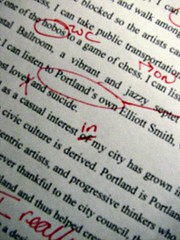There are probably as many ways to edit a story as there are to write one. One of my favorite tools has been a scene chart, inspired by a post on Edittorrent.
The original post suggested creating index cards for each scene, listing a  number of important features—everything from where and when the scene is set, to first and last lines, to “promises” made to the reader, to important details like descriptions. Then you could move the index cards around to resequence events or scenes, or play with the story without hurting your MS.
number of important features—everything from where and when the scene is set, to first and last lines, to “promises” made to the reader, to important details like descriptions. Then you could move the index cards around to resequence events or scenes, or play with the story without hurting your MS.
Like many of the commentators on the post, however, I used a spreadsheet to do this in a very small space. I also combined this with probably the most important thing I learned from Jack Bickham’s Scene & Structure—the structure of a scene and the importance of a scene goal—for the character, not just me as a writer. (More on scene goals next week!)
So here’s an example of the kind of scene chart I used, partially filled in for an imaginary story (anybody recognize the plot? Hint: it’s from an old card game). I didn’t use all of these columns myself (and if any of them aren’t clear, feel free to ask what I mean).
I liked this technique so well, I’ve used it on almost everything I’ve written since the first time I used it, more than four years ago. I can use it to make sure the vital elements of every scene are present.
Checking for these elements is a very powerful tool. It makes sure that:
- Each scene is vital to your story
- Each scene has direction and purpose
- Each scene keeps your reader engaged and interested
- The story is consistent in its details
- There are no loose threads or forgotten promises
We’ll talk more about how the scene chart helps with some of these elements over the next couple weeks.
What do you think? Do you use a form of scene charts? What’s your favorite high-level editing technique?
Photo credit: Aaron Brown


Hmmm, I do love me a good spreadsheet. (In my MyDocuments folder at work, there are currently 3,029 Excel files, dating back to 2007. Just to give you an idea.)
That is very interesting. I had read about using index cards, but I didn’t like it. Eventually, I just threw them into Notepad so that I could re-arrange and add notes as needed. I may have to try this out, “import” my current WIP and see how that looks.
Thanks, Jordan! This is a very cool idea. I’ll report back on my experience if it works for me. Otherwise, I may just conveniently forget about it.
Woot! Good luck, Jon!
I’ve always wanted to know how to use a spreadsheet to my benefit, and your example does just that. Thank you. I’ll start building one for my WIP today.